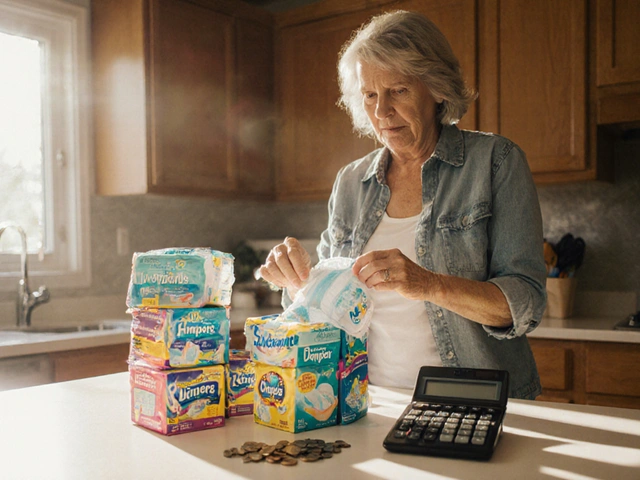When Urinary incontinence is a daily reality, the expense of managing it can feel endless. Between disposable pads, adult diapers, laundry, and occasional doctor visits, many families watch their grocery bill swell without a clear plan to control it. This guide breaks down where the money goes, shows where you can trim the fat, and gives you a playbook to keep the cost of incontinence products from draining your wallet.
Quick Takeaways
- Reusable cloth pads can cut monthly spend by up to 70% after the first year.
- Buying in bulk or through subscription clubs saves 15‑30% on disposables.
- Check Medicare, private insurers, and local health agencies for partial reimbursements.
- Track usage patterns; most people over‑order by 20‑40%.
- Maintain a simple cost‑per‑use calculator to stay on budget.
Understanding the Real Cost of Leakage Management
Most people start by tallying the price tag on the box of disposable pads they buy each month. That number is only the tip of the iceberg. Below are the hidden expenses that quickly add up:
- Product price. A pack of 30 disposable pads ranges from $25 to $45, depending on absorbency and brand.
- Laundry. If you use washable underwear, each wash adds water, detergent, and machine wear-roughly $0.30 per load.
- Replacement schedule. Disposable products must be changed multiple times a day, while reusable items need periodic replacement after 500‑800 washes.
- Medical appointments. Visits to a continence nurse or urologist can be $100‑$200 if not covered.
- Insurance and subsidies. Many people overlook what their plan actually pays for.
Pulling these figures together, the average household in Australia spends between $150 and $250 a year on basic supplies alone. For families with multiple sufferers, the number can double.
Reusable vs. Disposable: The Numbers Speak
Below is a side‑by‑side look at the two main product families. The data come from a 2024 consumer survey of 1,200 users across Sydney and Melbourne.
| Attribute | Disposable Pads | Reusable Cloth Pads |
|---|---|---|
| Up‑front Cost | $30‑$45 for a 30‑day supply | $70‑$110 for a starter kit (5‑7 pads) |
| Cost per Use | $1.00‑$1.50 | $0.05‑$0.08 (after wash) |
| Typical Lifespan | Single‑use | 500‑800 washes (≈2‑3years) |
| Environmental Impact | High - ~1kg waste per month per person | Low - washable fabric |
| Comfort Rating (survey) | 6/10 | 8/10 |
| Typical Price Range | $25‑$45 per pack | $70‑$110 starter kit |
Even though reusable pads require a bigger upfront spend, the cost per use drops dramatically after the first year. For a single user, the breakeven point is usually around 8‑10months.
Top Strategies to Slash Your Monthly Spend
Here are the most effective tactics that real‑world users have tried and verified.
- Bulk buying & subscription clubs. Many online retailers offer a 20‑30% discount when you sign up for a 6‑month auto‑ship. The key is to calculate your average daily usage first, then set the subscription to match.
- Mix and match. Use a disposable pad for high‑stress moments (travel, night) and rely on reusable pads for daytime at home.
- Shop pharmacy discount programs. Chains like Chemist Warehouse and Priceline run loyalty cards that shave $5‑$10 off each pack.
- Utilize Medicare and private health rebates. In Australia, the Medicare Benefits Schedule (MBS) lists Item 10929 for “continence products” - a partial refund for eligible patients. Your GP can provide a prescription that triggers the rebate.
- Local council subsidies. Some city councils run “Aged Care Support” initiatives that provide free reusable pads to low‑income seniors.
- DIY laundry hacks. Adding a half‑cup of white vinegar to the rinse cycle helps eliminate odor and extends the life of cloth pads by 15%.

Creating Your Personal Cost‑Per‑Use Calculator
Seeing the numbers in front of you can be eye‑opening. Grab a notebook or use a simple spreadsheet and plug in the following formula:
Cost per Use = (Total Product Cost + Laundry Cost + Replacement Cost) ÷ Total Uses
Example for a reusable kit:
- Starter kit = $90
- Average wash cost = $0.30 (detergent + water) × 2 washes per day = $0.60/day
- Replacement after 600 washes = $15 for a new pad set
- Total uses in a year (assuming 3 pads per day) = 1,095
Plugging in:
Cost per Use = ($90 + ($0.60 × 365) + $15) ÷ 1,095 ≈ $0.12 per use
Compare that to a disposable pad at $1.20 per use and you instantly see a saving of roughly $1.08 every time you change.
Insurance & Government Coverage Explained
Many readers assume that health insurance never touches incontinence supplies, but the reality is more nuanced. Below are the most common pathways to get partial or full reimbursement.
- Medicare Benefits Schedule (MBS) Item 10929. A doctor’s prescription triggers a 50% rebate on up to 30 packs per year.
- Private health funds. Some funds include “Continence Care” as an optional add‑on. Check the policy wording for “Durable Medical Equipment”.
- National Disability Insurance Scheme (NDIS). If you qualify, the NDIS can fund a “Daily Living” budget that covers reusable pads and even a supportive garment.
- State‑specific subsidies. NSW offers a “Seniors Health Pack” that includes a starter set of reusable pads at no cost for residents over 70.
When you approach a provider, have these items handy: the prescription, a copy of your Medicare card, and a recent invoice for the products you’re buying. That speeds up the claim process and reduces paperwork.
Putting It All Together: A 3‑Month Action Plan
Below is a practical checklist you can follow week by week.
- Week1 - Audit. Gather every receipt for the past three months. Add laundry detergent costs and total them.
- Week2 - Research. Compare at least three brands of reusable pads (e.g., Eco‑Padded, SureFit, ClothComfort). Note price, absorbency rating, and warranty.
- Week3 - Trial. Purchase a starter kit of the most promising brand. Use it for daytime at home while keeping disposables for night.
- Week4 - Calculate. Use the cost‑per‑use formula to see how much you saved versus pure disposables.
- Month2 - Optimize. If the trial saved at least 30%, convert all daytime use to reusable pads. Sign up for any bulk‑discount program you qualify for.
- Month3 - Claim. Submit a Medicare rebate claim with the prescription and a copy of the invoice. Follow up on any private health fund paperwork.
By the end of the quarter, most people report a 50‑70% drop in monthly out‑of‑pocket costs.
Common Pitfalls and How to Avoid Them
- Over‑ordering. Bulk packs sound cheap, but if you can’t use them before expiration you end up throwing money away.
- Skipping laundry care. Using fabric softener can break down the absorbent layer of cloth pads, shortening their life.
- Ignoring insurance. A missed prescription means you lose out on up to $500 per year in rebates.
- Choosing low‑absorbency for night use. Leads to more changes and higher cumulative cost.
Keep these pointers in mind and you’ll stay on the money‑saving track.

Frequently Asked Questions
Can I get a tax deduction for incontinence supplies?
If the products are prescribed by a medical professional, they can be claimed as a medical expense on your tax return, reducing taxable income. Keep all receipts and the prescription letter.
How often should I replace reusable pads?
Most manufacturers recommend replacement after 500‑800 washes or when the fabric shows signs of thinning. That usually translates to 2‑3years of daily use.
Are there any government programs for low‑income seniors?
Yes. In NSW, the Seniors Health Pack provides a starter set of reusable pads free of charge. Contact your local council health services to apply.
What’s the best way to wash reusable pads without losing absorbency?
Use warm water, a mild detergent, and skip fabric softener. Add half a cup of white vinegar to the rinse cycle to neutralize odors and preserve the absorbent fibers.
Does Medicare cover adult diapers?
Medicare can partially subsidise adult diapers when they’re prescribed under Item 10929. The rebate is 50% of the product cost, up to a capped number of packs per year.


Rama Hoetzlein
September 28, 2025 AT 08:41Wow, another guide telling you to “just switch to cloth pads” like it’s a magic wand 😡🙄. The reality is most people don’t even know how to wash them properly, so they end up with stinky leaks and wasted money. If you think the upfront cost is a barrier, you’re probably already broke from buying disposable packs that cost a fortune. Stop being a victim of marketing hype and actually track your usage before you throw cash away. The only thing more expensive than the pads is your ignorance 🤦♀️.
Lorena Garcia
September 29, 2025 AT 14:17Honestly, budgeting isn’t rocket science – just jot down every pack you buy for a month, add the detergent cost, and you’ll see the leak in your finances. A simple spreadsheet can turn that nightmare into a clear picture and give you confidence to chase those rebates. Remember, Medicare won’t pay itself, so claim that 50% rebate before you forget. Keep the receipts, set a reminder on your phone, and you’ll never miss a payout again.
Dietra Jones
September 30, 2025 AT 19:53Yo, if u’re thinkin bout goin cloth dont forget 2 add a lil white vinegr in the rins cycle – it keeps the odour away and the pads fresh. Also, buying a starter kit maybe pricey but u’ll save bucks fast once u get the hang of washin them. Dont skimp on the gentle detergeent or u’ll ruin the absorbency.
Victoria Guldenstern
October 2, 2025 AT 01:29So you read the whole article and now you feel like a financial guru because you can count pennies on pads it’s almost adorable how we all think a spreadsheet will miraculously solve the endless cycle of leakage expenses it’s true that numbers help but they also hide the emotional toll of wearing a product that feels like a prison for your body you could spend hours debating the merits of reusable versus disposable while the real issue remains that we are forced into a market that sells us fear and convenience at premium prices the solution isn’t just a cheap starter kit it’s also about demanding better coverage from insurers and pushing manufacturers to be transparent about longevity it’s not a hobby to calculate cost per use it’s a survival skill in a system that profits from our discomfort
Bill Bolmeier
October 3, 2025 AT 07:05Hey there! I get how overwhelming the whole thing can seem, but imagine the day you open your laundry and see those reusable pads sparkling clean – it’s a victory worth celebrating! Let’s ditch the shame and treat this like a heroic quest, one wash at a time. You’ve already taken the first step by reading this guide, now keep the momentum going and watch those savings pile up like applause after a great performance.
Darius Reed
October 4, 2025 AT 12:41Alright buddy, let’s talk about the *art* of bulk buying – it’s like painting a masterpiece with discounts as your colors but watch out for that sneaky expiration date hiding in the corner like a mischievous gremlin. If you over‑order you’ll end up tossing pads like bad jokes at a party, and that’s no fun. So mix a dash of caution with a splash of optimism and you’ll turn your wallet into a canvas of savings.
Karen Richardson
October 5, 2025 AT 18:17According to the latest data, the average household that transitions to reusable pads reduces its annual expenditure by approximately 65 percent. This calculation assumes consistent usage patterns and proper maintenance of the products. It is essential to verify that your health insurer covers the initial purchase costs, as many plans provide partial reimbursement. Documenting each transaction will facilitate accurate claim submissions and prevent unnecessary expenses.
AnGeL Zamorano Orozco
October 6, 2025 AT 23:53Listen up folks – the whole “just buy whatever’s cheap” mindset is a recipe for disaster and I’m not talking about the occasional budget slip it’s a systemic failure that keeps us chained to endless cycles of waste and regret every time you dump a pack of disposable pads into the trash you’re basically throwing money into a black hole and the only thing that will break this cycle is a fierce commitment to change and a willingness to endure a little inconvenience during the wash cycle it may sound like a hassle but think about the long‑term payoff you’ll be laughing at the saved dollars while everyone else is still drowning in receipts this is not a suggestion it’s a call to arms for your financial sanity
Cynthia Petersen
October 8, 2025 AT 05:29Sure, we could all continue splurging on disposable pads like it’s a luxury fashion statement, but why not try the revolutionary idea of actually saving money? It’s almost comical how a simple laundry routine can turn your budget around, and the best part is you get to feel smug every time you see the rebate hit your account. Keep that cheeky grin on, you’re doing better than most.
Marcia Hayes
July 31, 1975 AT 03:05Just set a reminder to claim your rebate each month.
Danielle de Oliveira Rosa
August 1, 1975 AT 08:41The act of managing incontinence supplies transcends mere economics; it reflects a deeper relationship between self‑care and societal responsibility. When we conscientiously choose reusable options, we not only reduce personal costs but also contribute to environmental stewardship. This alignment of personal well‑being with collective good embodies a form of ethical consumerism worth aspiring to.
Tarun Rajput
August 2, 1975 AT 14:17Embarking upon a systematic approach to curtailing expenses associated with urinary incontinence necessitates a multifaceted strategy that integrates meticulous data collection, analytical rigor, and proactive engagement with healthcare providers. The initial step involves constructing a comprehensive ledger that enumerates every expenditure, ranging from the purchase price of pads to ancillary costs such as detergent, water usage, and routine medical consultations. By categorizing these outlays, one can readily identify patterns of over‑consumption and pinpoint opportunities for economization. Subsequently, the consumer should evaluate the cost‑effectiveness of reusable versus disposable products, employing the established cost‑per‑use formula to derive a quantifiable comparison. It is imperative to factor in the depreciation rate of reusable pads, accounting for the eventual need for replacement after the stipulated 500‑800 wash cycles. Moreover, an exhaustive review of insurance policies and government subsidies should be undertaken, as many plans-particularly those governed by the Medicare Benefits Schedule-offer partial reimbursements that can significantly offset initial investments. In practice, the patient may procure a starter kit of high‑quality reusable pads, negotiate bulk purchase agreements with reputable suppliers, and synchronize these acquisitions with subscription services that provide automatic discounts. Parallel to these procurement measures, the individual ought to adopt best‑practice laundering techniques, such as the inclusion of white vinegar during the rinse phase, to prolong the functional lifespan of the fabric while preserving its absorbent properties. Continuous monitoring of the financial impact, through periodic recalculation of the cost‑per‑use metric, ensures that the adopted regimen remains optimal and responsive to any fluctuations in usage intensity or market pricing. Engaging with support groups or community forums can also furnish valuable anecdotal insights and foster a sense of solidarity among users facing similar challenges. Ultimately, by adhering to this rigorously structured plan, one can anticipate a reduction in out‑of‑pocket expenditures ranging from fifty to seventy percent, thereby transforming an ostensibly burdensome necessity into a manageable facet of daily living. Furthermore, tracking the environmental impact alongside financial savings can reinforce commitment to sustainable practices. The data can be visualized in simple charts, making the progress tangible and motivating. Should any reimbursement claim be denied, a documented trail of purchases and medical necessity will streamline the appeals process. Regular consultation with a continence nurse ensures that product selection remains clinically appropriate, preventing costly complications. Finally, sharing this methodology with family members can amplify the benefits across the household, fostering collective financial prudence.
Sharon Cohen
August 3, 1975 AT 19:53While most advice glorifies the switch to reusable pads, it’s worth noting that not everyone can accommodate the laundering routine, and for some the hidden costs of water and detergent may outweigh the savings.